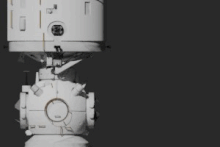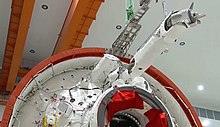Mengtian module
 Rendering of Mengtian lab module | |
| Module statistics | |
|---|---|
| COSPAR ID | 2022-143A |
| Part of | Tiangong space station |
| Launch date | 31 October 2022, 07:37:23 UTC[1] |
| Launch vehicle | Long March 5B (Y4) |
| Mass | ~22,000 kg (49,000 lb) in orbit At launch: ~23,000 kg (51,000 lb) |
| Length | 17.9 m (59 ft) |
| Diameter | 4.2 m (14 ft) |
| Pressurised volume | 109m3[2] habitable: 32m3[3] |
| Docking with Tiangong space station | |
| Docking port | Tianhe Forward |
| Docking date | 31 October 2022, 20:27 |
| Undocking date | 3 November 2022, 00:48 UTC |
| Time docked | 2 days, 4 hours and 21 minutes |
| Berthing at Tiangong space station (Relocation) | |
| Berthing port | Tianhe port side Port |
| Berthing date | 3 November 2022, 01:32 UTC |
| Time berthed | 2 years, 1 month and 29 days |

Mengtian (simplified Chinese: 梦天; traditional Chinese: 夢天; pinyin: Mèng Tiān; lit. 'Dreaming of the Heavens[4]'), officially the Mengtian laboratory cabin module (Chinese: 梦天实验舱), is a major module of the Tiangong space station. It is the second Laboratory Cabin Module launched, after Wentian, and the second module to extend the existing Tianhe core module of the station.[5] It was launched into orbit from the Wenchang Spacecraft Launch Site on 31 October 2022,[6] successfully docking with Tianhe forward port at 20:27 UTC on the same day.[7]
On 3 November 2022, Mengtian was relocated to the larboard port at 01:32 UTC[8] by indexing robot arm. On the same day at 07:12 UTC, the crew of Shenzhou 14 opened the hatch and entered the module for the first time.
Purpose
[edit]
The Mengtian module is equipped with expanded in-orbit experiment capacity, including eight research cabins.[9] It provides a pressurized environment for researchers to conduct science experiments in freefall or zero gravity which could not be conducted on Earth for more than a few minutes. Experiments can also be placed on the outside of the modules, for exposure to the space environment, cosmic rays, vacuum, and solar winds. It has its own airlock.

The axial port of Mengtian is fitted with rendezvous equipment and will first dock to the axial port of Tianhe. A mechanical arm known as the indexing robotic arm, similar to the Lyappa arm on the Mir space station, then moves Mengtian to a portside port of the TCM.[10][11][12] In addition to this arm used for docking relocation, the Chinarm on Tianhe module can also be used as a backup in place of the indexing robot arm.[13][14]

Mengtian also carries a toolbox equipped with a dexterous robotic arm, installed to assist in cargo transfer and payload release,[15] that can be used to launch microsatellites,[15][16] and an augmented-reality smart glass to assist astronauts with maintenance.
Similarly to the Wentian module, electrical power is provided by two steerable solar power arrays, which use photovoltaic cells to convert sunlight into electricity. With a wingspan of over 55 m (180 ft), each array has an energy collection area of 110 m2 (1184 square ft).[17] The energy is then stored to power the station when it passes into the Earth's shadow. Resupply ships will replenish fuel for LCM 2 for station-keeping, to counter the effects of atmospheric drag.
Aftermath
[edit]After launch, the Mengtian module was inserted into a low Earth orbit with an average altitude of 393 km (244 mi) at an orbital inclination of 42 degrees, centered in the Earth's thermosphere.[18][19] It successfully docked with the Tianhe core module nearly thirteen hours after launch.
Assembly
[edit]The Shenzhou 14 mission to the space station assisted with setting up the Mengtian module in orbit.[20]
Gallery
[edit]-
Mengtian lab module prior to launch
See also
[edit]References
[edit]- ^ Beil, Adrian (30 October 2022). "China launches Mengtian science module to Tiangong space station". NASASpaceFlight. Retrieved 31 October 2022.
- ^ 朱光辰 (2022). "我国载人航天器总体构型技术发展". 航天器工程. 第31卷 (第6期): 47.
- ^ 中国载人航天 (2022-10-30). "解码梦天(二)一组数字看懂梦天实验舱" (in Simplified Chinese). Retrieved 2022-10-31.
- ^ "Planned space station details made public". China Daily. 2018-04-26.
The two space labs, Wentian, or Quest for Heavens, and Mengtian, or Dreaming of Heavens
- ^ "SCIO briefing about China's progress on space station construction | english.scio.gov.cn". english.scio.gov.cn. Retrieved 2022-04-18.
- ^ The Associated Press (31 October 2022). "China launches 3rd and final space station component". ABC News.
- ^ Jones, Andrew (31 October 2022). "Final module docks at China's Tiangong space station". SpaceNews. Retrieved 1 November 2022.
- ^ China 'N Asia Spaceflight [@CNSpaceflight] (3 November 2022). "Official completion time of Mengtian relocation is 01:32UTC" (Tweet). Retrieved 3 November 2022 – via Twitter.
- ^ Ling, Xin (12 October 2022). "China's space station prepares for new frontiers of science with launch of Mengtian module". South China Morning Post.
- ^ Graham, William; Gebhardt, Chris (April 28, 2021). "China readies launch of Tianhe module, start of ambitious two-year station construction effort". NASASpaceflight.com.
This means the two future science modules, Wentian ("Quest for the heavens") and Mengtian ("Dreaming of the heavens"), cannot dock directly to their planned radial port locations. [...] To account for this, each module will carry a Russian Lyappa robotic arm — like the ones used on Mir for the same purpose — to move the module from the forward port to its respective permanent location on a radial port of Tianhe's docking hub.
- ^ Hong Yang (2020). Manned Spacecraft Technologies. Singapore: Springer. ISBN 978-9811548970.
- ^ Graham, William; Gebhardt, Chris (April 28, 2021). "China readies launch of Tianhe module, start of ambitious two-year station construction effort". NASASpaceflight.com.
- ^ Hong Yang (2020). Manned Spacecraft Technologies. China: Springer. p. 355. ISBN 978-9811548970.
- ^ Graham, William; Gebhardt, Chris (April 28, 2021). "China readies launch of Tianhe module, start of ambitious two-year station construction effort". NASASpaceflight.com.
- ^ a b Beil, Adrian (30 October 2022). "China launches Mengtian science module to Tiangong space station". NASASpaceFlight. Retrieved 31 October 2022.
- ^ Xinhua (31 October 2022). "China launches lab module Mengtian as space station approaches completion". China News Service.
- ^ Andrew Jones published (2022-08-13). "See the huge solar wings of China's space station in motion above Earth (video)". Space.com. Retrieved 2022-11-12.
- ^ Barbosa, Rui C. (1 March 2021). "China preparing to build Tiangong station in 2021, complete by 2022". NASASpaceFlight. Retrieved 15 March 2021.
- ^ David, Leonard (7 March 2011). "China Details Ambitious Space Station Goals". Space.com. Retrieved 23 February 2012.
- ^ "Completion of the Heavenly Palace: Tiangong in 2022 - Dongfang Hour". 4 February 2022.

